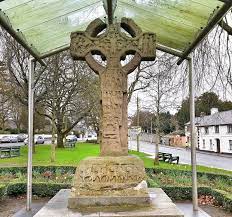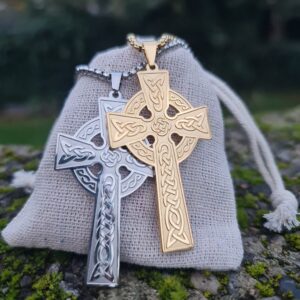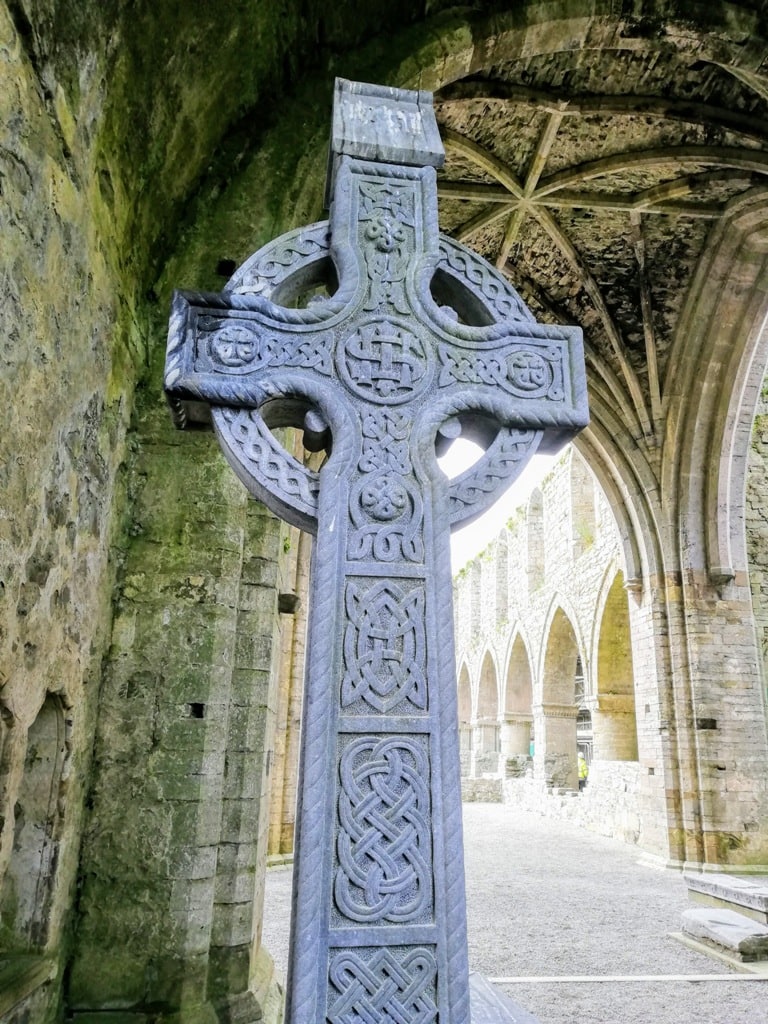The Celtic cross is a unique blend of two cultural symbols. The first, the cross, is a symbol that has been found in many religious cultures and societies throughout history. It’s associated with faith and hope. The second is the Sun Circle. The Sun Circle is the ring contained within the Celtic Cross. Combining these two historical motifs has resulted in stunning artifacts such as the Celtic Cross that honor both the spiritual and cultural heritage of the Celts.
Celtic Cross
The traditional interpretation of a Celtic cross includes four sections: each corner contains a circle to represent eternity or cyclical nature; at their center lies a four-armed cross which stands for Christianity; below this iconic image is often another design element that forms either another Cross or ornate knotwork pattern which speaks to pre-Christian roots of Celtic culture; finally there are also inscriptions on most versions of the crosses that read “IHS” meaning ‘Jesus’ or sometimes “INRI” meaning Jesus Christ King Of Jews’.
What makes these artifacts so special is their mix of Christian symbolism with ancient Celtic symbols and their widespread use in monuments from Ireland, Scotland, Wales, Britain, France, and Brittany regions. These items carry more meaning than just physical decoration – they present stories about our ancestor’s beliefs and everyday lives back then.
Some examples include those seen in churches or cemeteries around Europe today whilst others might have been hung up in homes during medieval times as protection amulets against evil spirits – talk about versatility. Others again may have been featured on jewelry pieces worn by royalty who wanted to display their power yet pay respect at the same time. Each one tells its own story depending on the period it was created from different tribal patterns & scripts used all making them unique works of artistry indeed!
Origins
The Celtic cross has a long and fascinating history. It is said to be symbolic of the Celtic people’s reverence for both spiritual and terrestrial worlds. Its origin story dates back to the Celtic pagan symbol known as the Sun Cross. The Sun Cross was an important symbol to the pagan Celts who used it in religious rituals. Over time, the Sun Cross morphed into the Celtic Cross, and its popularity spread throughout Europe, eventually becoming a dominant form of sacred art in many cultures.

The shape of a Sun Cross is thought to represent the four elements – air, water, earth, and fire – that are essential components of life. These four points also represent the sun’s path through each season as well as its cycle of dying and rising again each day. In this way, it was used by early Celts not only as a sign of their faith but also as an expression of their deep connection with nature’s powerful forces.
Moreover, since early times the Celtic Cross was believed to ward off evil spirits or offer protection from harm against enemies. This idea likely stems from its circular shape which resembles an anchor or shield – symbols commonly associated with safety during battle or dangerous situations in ancient times. Worn as an amulet for protection against evil forces or to bring luck in battle, it had a strong connection to nature and spirituality. This powerful representation of faith has endured centuries of cultural shifts yet remains relevant today.
Is the Celtic Cross Christian
Is the Celtic Cross Christian? This is a question that I often hear asked by people who aren’t familiar with the subject. The use of the word Christian and Cross in association with Celtic can confuse. Surely as the Celts were pagan, this would mean it is a pagan symbol? But wait, Crosses are Christian?
While the Celtic Cross is of course associated with Christianity, especially in Ireland, its origins are believed to predate the arrival of Christianity in the lands occupied by the Celts. The symbol is thought to have originated from the Sun Cross as mentioned previously. Many pagan civilisations worshipped the Sun, as well as other celestial bodies, but also it gets its name from the intricate Celtic Knotwork that typically is found engraved in Celtic Crosses. The most common form of Knotwork found in the Trinity/Celtic Knot.
Is the Celtic Cross Protestant or Catholic?
Is the Celtic Cross Protestant or Catholic is another frequently asked question. Again, the confusion here is understandable. Scottish and Irish people are the most commonly known Celtic people. Irish people tend to be mostly Catholic (Northern Ireland is roughly split 50/50), whereas Scotland tends to be mostly Protestant. Celtic Crosses are found in both regions.
The answer is both, but nowadays it is primarily used by Catholics. The reason is that the Celtic Cross was a Celtic Christian symbol before the separation of the Christian faith into the two different strands of Christianity, Catholicism, and Protestantism.
The reason that the Celtic Cross has been co-opted more by Catholics is likely due to the Sectarian conflict that occurred between both groups in Northern Ireland. Northern Ireland protestants heavily associated with British culture and would identify as being of Anglo-Saxon origin. Catholics associated with Irish culture and would identify as Celts.
In Scotland, this would not be as pronounced due to the lesser role of sectarianism. Both Catholics and Protestants in Scotland would identify as being of Celtic origin.
Celtic Knot Cross
The Celtic Knot Cross is the most common form of the Celtic Cross found in Ireland. It contains the Triquetra or Trinity Knot. The Celtic Cross with Trinity Knot as it is often known is a beautiful testament to Celtic Ireland.
Celtic Cross Jewelry & Art – Ancient Examples
The Celtic Cross has been an important symbol in art and jewelry for centuries. Ancient examples of the Celtic Cross can be found in stone carvings, illuminated manuscripts, and metalwork. One of the earliest known stone crosses erected in Ireland is the Tullylease Cross. This dates back to the 7th or 8th century and is located in my homeland of County Cork, Ireland. This cross features intricate carvings, including Celtic knotwork, biblical scenes, and other decorative elements.
Another ancient example is the Cross of Kells, a 9th-century stone cross located in Kells, County Meath, Ireland. The Cross of Kells is adorned with intricate Celtic patterns and biblical scenes, showcasing the craftsmanship of the time.

Illuminated manuscripts, such as the Book of Kells and the Lindisfarne Gospels, also feature the Celtic Cross in their elaborate illustrations. These manuscripts are known for their intricate knotwork and detailed depictions of biblical scenes, with the Celtic Cross serving as a unifying symbol of the fusion of Christian and Celtic art.
Celtic Cross Jewelry & Art – Modern Usages
Modern interpretations of this classic icon are no less breathtaking than their ancient predecessors. Whether it’s displayed as Celtic Cross jewelry, such as Celtic Cross earrings or Celtic Cross Pendants, or artwork. Other Contemporary examples can be found in various mediums, including metalwork, glasswork, wood carving, and textiles. The symbol has been adapted and reinterpreted by artists, resulting in a diverse range of designs.

Celtic Cross Spiritual Meaning
They are ancient symbols of faith that remain popular today, known for their iconic design and ability to communicate cultural or spiritual messages. The most recognizable form is a combination of the traditional Christian cross with a circle around its midsection, typically adorned with elaborate knots and decorative carvings. Each of these elements has a unique meaning behind it, creating an emblem rich in sacred symbolism.
The Christian cross at the heart represents Jesus’s sacrifice on Calvary Hill while its circular border symbolizes eternity – representing heaven, earth, and all existence between them. Some consider this eternal realm to represent a connection between humanity and God, as well as hope for endless life beyond death. This combination speaks powerfully to those who believe in such things; providing peace and comfort during trying times by reminding us that our souls exist forevermore.
Knotwork patterns often found on Celtic Crosses carry additional layers of meaning from Irish myths which portray knots as symbols of unending strength or immortal love stories between mortals & gods alike; furthering this imagery of everlasting life or protection from danger or evil influence even in death. Through its elaborate designs, it carries deep significance for believers everywhere; serving as an inspirational visual reminder to persevere through difficult moments no matter what comes your way.
Ancient Origins
Originating from the Iron Age Sun Cross, this ornate symbol was popularly used by Celts and is believed to have originated in Ireland or Wales around 600 B.C. Representing an interconnection between their spiritual beliefs and the nature they surrounded themselves with.
This iconic symbol spread quickly throughout Europe making its way through Medieval times and embodying similar symbols across different cultures such as the symbol of the swastika appearing further east – leaving behind remains from past civilizations attesting to the continuous evolution this piece transcends without ever losing sight of its basic concepts instilled by ancient societies so many years ago.
Celtic Cross Meaning
It has been a symbol of faith and identity for centuries, with its powerful combination of circles, lines, and curves that weave together. It is believed to be one of the oldest Christian symbols, stemming from Celtic traditions during the 5th century. When deciphering the meaning behind this ancient iconography, several distinct interpretations exist.
The most widely accepted explanation centers around Christ’s crucifixion – the horizontal beam representing his outstretched arms and the vertical beam as his body – intersecting in a symbolic ‘cross’. The four smaller limbs connected to it represent our 4 cardinal directions: north (upwards), south (downwards), east (right), and west (left). This conveys the idea that even though Christ was crucified on earth in a specific location, his death had universal implications for believers everywhere.
In addition to recognizing Jesus’ physical sacrifice on Earth, other interpretations incorporate spiritual symbolism as well. For instance, some scholars suggest each arm of the cross represents a different element -earthly desires, material possessions, heavenly aspirations, and spiritual awareness- offering believers an understanding that life should be lived from all angles including mental and physical aspects. This perspective reflects a balance between worlds and stresses peace while striving for higher consciousness.
There is always something special about seeing these sacred images immortalized in jewelry or on stained glass windows – serving as lasting visual reminders of faith’s existence despite hardship or despair. Whether seen through eyes of religious conviction or more abstract interpretation; ultimately these ancient symbols continue to bring joy today through their beauty and enduring power.
Celtic Cross Circle Meaning (Inner Ring)
Although its exact origins are disputed, some experts believe it goes all the way back to the fourth century when a circle was added to a pre-existing Latin cross to emphasize Christ’s role as the sun of God. This is where the theory of the Sun Cross evolving into the Celtic Cross comes from. It was also during this time that Celtic artisans began carving them out of stone or metal, thus helping spread their popularity even further.
Why is the Celtic Cross bad?
Why is the Celtic Cross bad is another question I have heard often.
It is in itself, is not a negative or harmful symbol. However, it has gained a somewhat negative reputation among some people due to its association with tarot readings. The Celtic Cross is a popular tarot card spread, which is used to gain insight into various aspects of a person’s life, such as their past, present, and future circumstances. Tarot readings, have been associated (rightly or wrongly) with dark and occult practices, which has contributed to the negative perception of the Celtic Cross in the eyes of the general public.
It is important to note that as a symbol it has a rich and diverse history that extends far beyond its association with tarot readings. Its spiritual and cultural significance, as well as its artistic and aesthetic appeal, have made the Celtic Cross a beloved and enduring emblem that continues to captivate and inspire people around the world. So the next time someone asks why is the Celtic Cross bad, make sure to tell them that it isn’t!
Celtic Crosses in Popular Culture
It has made its way into popular culture in various forms, from music and literature to television and film. In music, Celtic bands and musicians often incorporate the Celtic Cross into their album covers, stage designs, or merchandise, as a way to express their connection to Celtic heritage and spirituality. Bands such as Dropkick Murphys, Flogging Molly, and The Pogues have featured the Celtic Cross in their logos or artwork, showcasing the symbol’s widespread appeal and recognition.
In literature, it has appeared in various genres, including historical fiction, fantasy, and romance. Novels set in Celtic regions or featuring Celtic characters often include references to the Celtic Cross, whether in descriptions of architecture, art, or as a meaningful symbol for the characters.
Television and film have also embraced the Celtic Cross as a visual element, particularly in productions that focus on Celtic history, mythology, or folklore.The symbol can also be seen in different movies and tv shows. Example include Braveheart, Outlander, and the Vikings. The latter of which is also filmed in Ireland.
Celtic Cross and Symbolism in World Cultures
While the Celtic Cross is most commonly associated with Celtic culture, it is worth noting that similar symbols can be found in various world cultures. The sun cross, which predates the Celtic Cross, can be found in ancient civilizations such as the Mesopotamians, Egyptians, and Native Americans. These cultures used the sun cross to represent the sun, the cycles of life, and the balance of opposites.
In a broader context, the symbolism of the cross and circle can be found in various cultures and spiritual traditions, often representing the interconnectedness of all things and the unity of opposites. This shared symbolism highlights the universal appeal of the Celtic Cross and its enduring relevance in the modern world.
Preservation of Celtic Cross Monuments
As a testament to the historical and cultural significance of the Celtic Cross, efforts have been made to preserve and protect ancient Celtic Cross monuments. Organizations such as the National Monuments Service in Ireland and Historic Environment Scotland are dedicated to conserving these monuments, which are an integral part of Celtic heritage.
These organizations work to document, restore, and maintain Celtic Crosses, ensuring that they are protected from damage or vandalism. They also provide educational resources and promote awareness of the cultural and historical importance of these monuments, helping to ensure that the Celtic Cross remains a cherished symbol for generations to come.
In conclusion, the Celtic Cross is a powerful and enduring symbol that holds deep spiritual, historical, and cultural significance. Its origins and meanings have evolved over time, shaped by both Christian and pagan traditions. Today, the Celtic Cross remains a popular symbol in art, jewelry, and popular culture, serving as a reminder of the rich and diverse heritage of the Celtic nations.
Celtic Cross and National Identity
The Celtic Cross has become an emblem of national identity for many people in Ireland, Scotland, and Wales. As a powerful symbol of Celtic heritage, the Celtic Cross is often displayed on flags, emblems, and other forms of national iconography. This strong connection to national identity is a testament to the deep cultural and historical roots of the Celtic Cross, which has transcended religious boundaries and become a unifying symbol for the Celtic people.
The Enduring Legacy of the Celtic Cross
The enduring legacy of the Celtic Cross is a testament to its profound spiritual, cultural, and historical significance. Over the centuries, the symbol has evolved and adapted to the changing beliefs and values of the Celtic people, while also influencing the art, architecture, and iconography of other cultures.
Today, the Celtic Cross continues to captivate and inspire people from all walks of life, serving as a powerful reminder of the rich heritage and diverse spiritual traditions of the Celtic nations. Whether encountered in ancient stone carvings, contemporary jewelry designs, or personal spiritual practices, the Celtic Cross remains an enduring symbol of faith, Christianity, and our ancestors.

